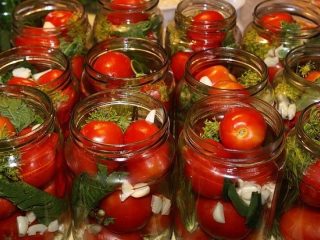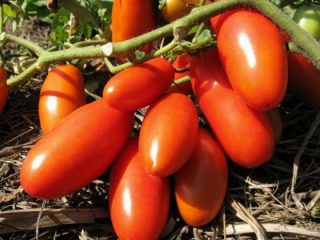Content
The tomato is native to South America, where it grows wild as a perennial vine. In harsher European conditions, the tomato can only grow as an annual unless grown in a greenhouse.
The Italian name for the overseas curiosity pomo d’oro and the original Aztec “tomatl” through the French tomate gave equivalent names to this berry in Russian: tomato and tomato.
Wild tomato in the Galapagos Islands
The tomato brought to Europe was initially only an indeterminate plant, that is, growing continuously as long as it was warm enough. At home or in a greenhouse, such a tomato may well grow into a long vine or tree. But the plant does not tolerate frost at all; it is relatively cold-resistant (papaya, for example, requires an air temperature of at least 15 ° C). When frosts occur, tomato bushes die, so for a long time it was believed that tomatoes cannot be grown in the northern regions. But by the end of the 19th century, Russian gardeners learned to grow tomatoes even in the northern provinces.
In Russian conditions, tomatoes have to be grown through seedlings or in greenhouses.Often, seedlings of tomato varieties intended for open ground must first be hardened off in a greenhouse, planting them in an open garden bed only in June, when the air temperature is already consistently above 10°C.
The optimal choice for open ground are determinate varieties of tomatoes, which stop growing after reaching a genetically determined limit. These varieties are not very suitable for greenhouses, although they are planted around the perimeter, since due to their low growth, bushes of these varieties are not able to use the entire usable area of the greenhouse. In the same time indeterminate varieties of tomatoes, planted in open ground, do not reveal their full potential, since they do not have enough warm time of year.
True, determinate varieties of tomatoes often have a disadvantage that indeterminate varieties do not have: the fruits become smaller towards the top. But there is also an advantage: the growth of the main stem stops after the formation of several inflorescences and these tomato varieties produce a much more intensive harvest than indeterminate ones.
When choosing varieties for open ground, you should take into account the region in which the tomatoes will be grown. If in the southern regions you can practically ignore early ripening, then in the northern regions this is a very important factor, often determining the choice of tomato variety.
For open ground, especially in the Trans-Ural regions, it is better to select tomato varieties belonging to the following groups:
- super-early with a growing season of up to 75 days;
- early ripening. From 75 to 90 days;
- mid-season. From 90 to 100 days.
Tomato seedlings are usually sown in March. If the deadlines have been missed, you need to select earlier varieties of tomatoes.In the northern regions, when sowing late, it is better to abandon mid-ripening varieties, in the south - from late-ripening ones.
Determinate varieties of tomatoes for open ground are the vast majority of all tomato varieties that are sown in beds under the open sky. Indeterminate ones are much less common in open beds.
Determinate and indeterminate tomatoes:
Determinate tomatoes for open ground
Tomato "Little Red Riding Hood"
An early-ripening tomato variety for the south and mid-ripening for more northern regions with a growing season of 95 days. The bush is 70 cm high and does not require pinching. The tomato does not require special feeding, but will appreciate the application of fertilizers. The yield of one bush is 2 kg.
The tomatoes are not large, maximum 70 g. The skin of the tomatoes is thin, they are well suited for fresh consumption or for preparing assorted vegetables for the winter. Not very good for whole-fruit canning due to the thin skin.
The variety is resistant to many tomato diseases, including late blight, and to temperature fluctuations. Can tolerate short-term drops in temperature.
Tomato "Alpatieva 905 a"
Mid-season tomato variety. The bush is low, up to 45 cm, determinant, standard. For this tomato, mid-ripening is determined by the southern regions, since its growing season is 110 days, although, according to the register, it is recommended for outdoor cultivation both in the Middle Zone and in the Ural region and Eastern Siberia.
Small tomatoes, 60 g. 3-4 ovaries are formed on one brush. The variety is productive and has industrial value. 2 kg of tomatoes are removed from one bush, planting 4-5 bushes per m².
Densely leafy, upright tomato bushes do not require pinching and need staking only when there are a very large number of tomatoes.After the bush reaches a height of 20 cm, the lower leaves are torn off.
In the register, the tomato variety is declared as a salad variety, although it will not impress with its special taste. The tomato has a characteristic tomato taste. But it is good for winter preparations.
For this reason, the variety has advantages over other salad tomato varieties.
The advantages of the variety are also:
- friendly ripening (in the first 2 weeks up to 30% of the harvest);
- resistance to sudden temperature changes;
- undemanding to growing conditions, which is why the Alpatieva 905 a is an excellent simulator for novice gardeners.
Since this is a variety and not a hybrid, its seeds can be saved for next year. To collect seeds, 2-3 tomatoes are left on the bush until fully ripe. You need to remove them before they begin to creep under your hand.
The seeds are removed from the tomato and left to ferment for 2-3 days, after which they are washed well with clean water and dried. Tomato seeds remain viable for 7-9 years. But the optimal age of tomato seeds is from 1 to 3 years. Further, germination begins to decline.
Tomato "Caspar F1"
Determinate high-yielding tomato hybrid, bred in Holland, with a growing season of 100 days. The height of the bush is 0.5-1 m. The stem of “Caspar F1” tends to creep along the ground and produce a significant number of stepsons. To avoid excessive growth of the bush, it is formed by pinching into two stems.
It is precisely breaking off the stepson in this way that inhibits the emergence of a new shoot in the same place. There is no need to pluck or pull out the stepson.
8 bushes of this tomato variety are planted per square meter.The bush must be tied up so that the tomatoes do not come into contact with the ground.
Tomatoes are red, elongated, weighing 130 g. Designed for open ground.
A new tomato variety, included in the register only in 2015. Suitable for cultivation in all regions of Russia. The hybrid is undemanding to care and is suitable for beginner vegetable growers. Loves abundant and frequent watering.
The tomato is considered universal, but when preparing salads, the tough skin must be removed. Well suited for preservation, as the thick skin prevents the tomato from cracking. Ideal for canning in its own juice.
Resistant to tomato diseases and pests.
Tomato "Junior F1"
An ultra-early ripening tomato hybrid from the Semco Junior company, producing fruits already 80 days after germination. Designed for cultivation in small farms and subsidiary plots.
The bush is superdeterminate, 0.5 m high. 7-8 ovaries are formed on the brush. Bushes of this tomato are planted 6 pieces per m².
Tomatoes weighing up to 100 g. Productivity 2 kg per bush.
With a large number of fruits, tomatoes grow small, with a small number, large ones. The total mass per unit area remains practically unchanged.
“Junior” is a universal variety of tomatoes, recommended, among other things, for fresh consumption.
The advantages of the hybrid are:
- crack resistance;
- precocity;
- good taste;
- resistance to diseases.
Due to the early ripening of tomatoes, the harvest is harvested even before late blight spreads.
How to get a harvest several times larger than usual
To obtain a large harvest, it is necessary to form a powerful root system in the plant.The method of such formation was developed more than 30 years ago. The tomato bush has the ability to form additional roots, and the method of forming additional roots is based on this.
To do this, the seedlings are planted in a “lying” position, that is, not only the root is placed in the groove, but also 2-3 lower stems with the leaves removed. 10 cm of soil is poured on top. Seedlings must be placed in the furrows strictly from south to north so that the seedlings, stretching towards the sun, rise from the ground and form into a normal, vertically growing bush.
On the buried stems, roots are formed, which are included in the general root system of the bush and are superior in efficiency and size to the main one.
The second way to get the roots you need is even easier. It is enough to let the lower stepsons grow longer, then bend them to the ground and sprinkle them with a 10 cm layer of soil, after tearing off the unnecessary leaves. The stepsons quickly take root and grow, and after a month they become practically indistinguishable from the main bush either in height or in the number of ovaries. At the same time, they bear fruit abundantly in close proximity to the ground.
If the seedlings have grown too tall, they are planted in the ground so that the top is 30 cm above the soil, having previously torn off all the lower leaves 3-4 days before planting, but leaving cuttings a couple of centimeters long from them, which will later fall off on their own. The bed with such seedlings is not loosened in the summer. Roots accidentally exposed during watering are sprinkled with peat.
Mistakes when growing tomatoes
How to get a good harvest
Reviews
Summing up
For open ground, it is better to choose the earliest determinate varieties of tomatoes, then there will be a guarantee that they will have time to ripen. And today there are a lot of varieties, there is one for every taste and color.
















